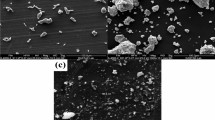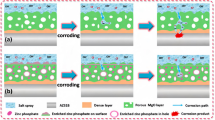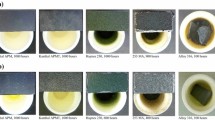Abstract
It is shown that heating of an internal layer of microarc coating up to temperatures at which insignificant rates of heat removal from microdischarges that possess a temperature of no less than 1200°C are ensured leads to realization of a sufficient time interval for the occurrence of almost 100% transformation of low-temperature aluminum-oxide modifications into high-temperature ones. Insufficient heating of a number of areas of the coating to these temperatures is the main reason for formation of a composite microarc coating that contains both low- and high-temperature aluminum-oxide modifications in its internal layer.
Similar content being viewed by others
References
Aver’yanov, E.E., Spravochnik po anodirovaniyu (Anodizing handbook), Moscow: Mashinostroenie, 1988.
Tomashov, N.D., Zalivalov, F.P., and Tyukina, M.N., Tolstosloinoe anodirovanie alyuminiya i ego splavov (Thick-layer anodizing of aluminum and its alloys), Moscow: Mashinostroenie, 1968.
Bakovets, V.V., Polyakov, O.V., and Dolgovesova, I.P., Plazmennoelektroliticheskaya anodnaya obrabotka metallov (Plasma-electrolytic anodic treatment of metals), Novosibirsk: Nauka. Sibirskoe otdelenie, 1990.
Chernenko, V.I., Snezhko, L.A., and Papanova, I.I., Poluchenie pokrytii anodno-iskrovym elektrolizom (Formation of coatings using anode-spark electrolysis), Leningrad: Khimiya, 1991.
Suminov, I.V., Epel’fel’d, A.V., Lyudin, V.B., et al., Mikrodugovoe oksidirovanie (teoriya, tekhnologiya, oborudovanie) (Microarc oxidation (theory, technology, equipment)), Moscow: EKOMET, 2005.
Slonova, A.I. and Terleeva, O.P., Morphology, structure, and phase composition of microplasma coatings formed on Al-Cu-Mg alloy, Prot. Met. Phys. Chem. Surf., 2008, vol. 44, no. 1, pp. 72–83.
Yerokhin, A.L., Snisko, A.L., Gurevina, N.L., et al., Discharge characterization in plasma electrolytic oxidation of aluminium, J. of Physics D: Applied Physics, 2003, vol. 36, pp. 2110–2120.
Khimicheskaya entsiklopediya (Chemical encyclopedia), Moscow: Sov. entsiklopediya, 1988, vol. 1, p. 623.
Markov, G.A., Terleeva, O.P., and Shulepko, E.K., Mikrodugovye i dugovye metody naneseniya zashchitnykh pokrytii, in Nauch. tr. MINKhiGP im. Gubkina. Vyp. 185. Povyshenie iznosostoikosti detalei gazoneftyanogo oborudovaniya za schet realizatsii effekta izbiratel’nogo perenosa i sozdaniya iznosostoikikh pokrytii (Scientific works of Gubkin MIOCG, issue 185. Increase of wear-resistance of oil and gas equipment parts due to realization of selective transfer effect and development of wear-resistant coatings), Moscow, 1985, pp. 54–64.
Dunleavy, C.S., Golosnoy, I.O., Curran, J.A., and Clyne, T.W., Characterisation of discharge events during plasma electrolytic oxidation, Surf. Coat. Technol., 2009, vol. 203, pp. 3410–3419.
McPherson, R., Formation of metastable phases in flame and plasma-prepared alumina, J. Mater. Sci., 1973, no. 8, pp. 851–858.
Rakoch, A.G., Khokhlov, V.V., Bautin, V.A., et al., Model representations of mechanism of microarc oxidation of metallic materials and control of this process, Prot. Met. Phys. Chem. Surf., 2006, vol. 42, no. 2, pp. 173–184.
Rakoch, A.G., Bardin, I.V., Kovalev, V.L., and Avanesyan, T.G., Microarc oxidation of light construction alloys. P. 1. Basic concepts of microarc oxidation of light construction alloys, Izv. Vuzov. Poroshkovaya metallurgiya i funktsional’nye pokrytiya, 2011, no. 2, pp. 58–62.
Rakoch, A.G., Bardin, I.V., Kovalev, V.L., and Avanesyan, T.G., Microarc oxidation of light construction alloys. P. 2. Effect of current form on kinetics of microarc coating growth on surface of light construction alloys in basic (pH ≤ 12.5) electrolytes, Izv. Vuzov. Poroshkovaya metallurgiya i funktsional’nye pokrytiya, 2011, no. 3, pp. 59–62.
Tillous, E.K., Toll-Duchanoy, T., and Bauer-Grosse, E., Microstructure and 3d microtomographic characterization of porosity of mao surface layers formed on aluminium and 2214 t6 alloy, Surf. Coat. Technol, 2009, vol. 203, no. 13, pp. 1850–1855.
Krivandin, V.A., Arutyunov, V.A., Belousov, V.V., et al., Teplotekhnika metallurgicheskogo proizvodstva. T. 1. Teoreticheskie osnovy: Ucheb. posobie dlya vuzov (Heat and mass transfer: workbook for higher education), Moscow: MISiS, 2002.
Pribytkov, I.A., Teplomassoobmen: Ucheb.-metod. posobie (Heat and mass transfer: study and methodology manual), Moscow: Ucheba, 2002.
Matykina, E., Arrabal, R., Mohamed, A., et al., Corros. Sci., 2009, no. 51, pp. 2897–2905.
Author information
Authors and Affiliations
Corresponding author
Additional information
Original Russian Text © A.G. Rakoch, A.A. Gladkova, V.L. Kovalev, A.G. Seferyan, 2012, published in Korroziya: Materialy, Zashchita, 2012, No. 11, pp. 31–35.
Rights and permissions
About this article
Cite this article
Rakoch, A.G., Gladkova, A.A., Kovalev, V.L. et al. The mechanism of formation of composite microarc coatings on aluminum alloys. Prot Met Phys Chem Surf 49, 880–884 (2013). https://doi.org/10.1134/S2070205113070125
Received:
Published:
Issue Date:
DOI: https://doi.org/10.1134/S2070205113070125




